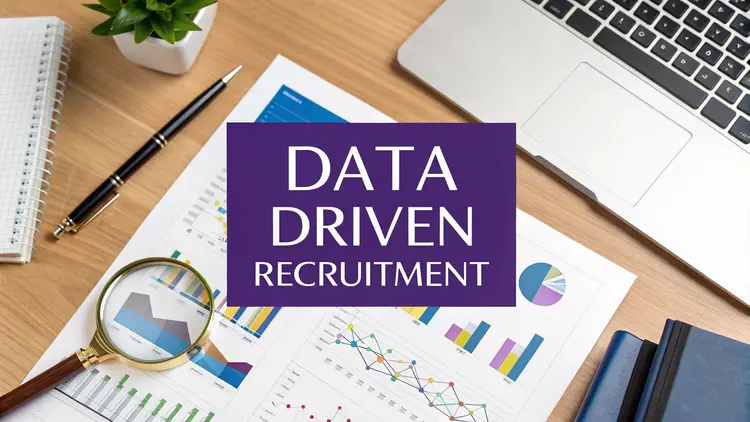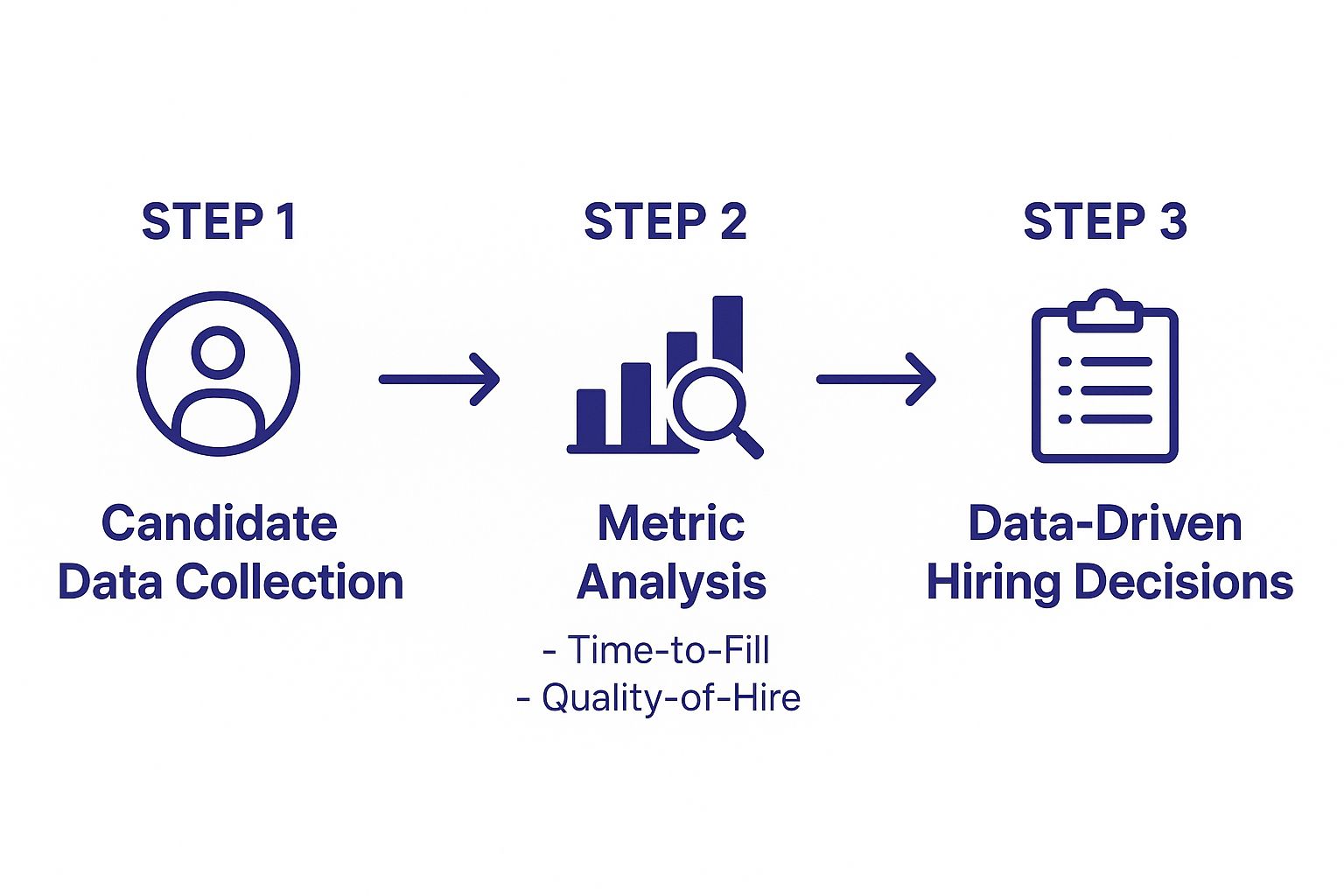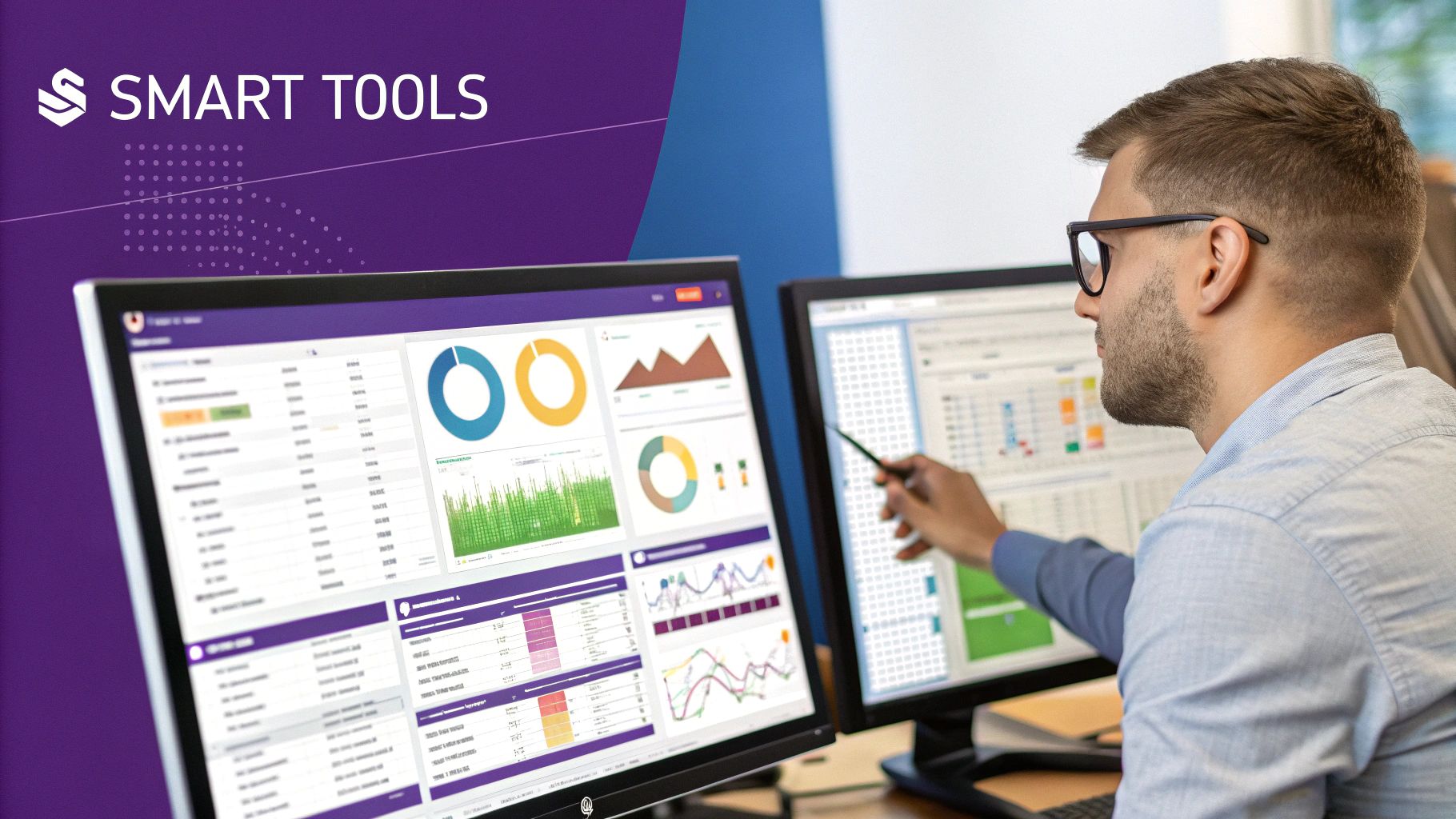HR Metrics
Data Driven Recruitment: Boost Hiring Success Today

Why Smart Companies Are Shifting Away from Gut-Feel Hiring
For years, hiring decisions often relied on a combination of experience, intuition, and a subjective "gut feeling." A firm handshake and a confident interview performance were considered reliable indicators of a promising employee. However, consider this frequent scenario: after investing months and substantial funds in hiring a seemingly ideal candidate, they resign within six weeks. This isn't just a nightmare; it’s a costly reality for many companies, highlighting a significant flaw in traditional hiring practices. Relying on instinct, while familiar, is proving to be an expensive and unreliable method for building a strong team.
Listen to the Podcast Here:

Progressive companies are now moving beyond this guesswork. They are embracing data-driven recruitment, which views hiring more as a science than an art. Imagine a detective solving a case. A diligent detective doesn’t rely on a hunch; they carefully collect evidence, analyse clues, and follow a logical process to uncover the truth. Similarly, a data-driven approach involves collecting and analysing recruitment data to determine what truly predicts success. It's about replacing assumptions with evidence and transforming your hiring process into a strategic, repeatable system that produces clear results.
The Real Cost of a Poor Hire
The consequences of a bad hiring decision extend far beyond initial recruitment fees and salary. A poor hire can disrupt team morale, consume management time with additional supervision, and even harm client relationships. When you factor in lost productivity, the cost of finding and training a replacement, and the negative impact on company culture, the total expense can be three to four times the employee's annual salary. This is why the shift towards evidence-based hiring is not just a fleeting trend; it's a crucial business strategy.
Data-driven recruitment provides tools to manage these risks. By examining historical hiring data, organisations can identify patterns that gut instincts might overlook. For instance, the data might reveal that candidates from a particular job board consistently perform better and remain longer, or that certain interview questions are more effective at predicting success on the job. This information enables recruitment teams to focus their efforts and budget where they will have the most impact, making the entire process more efficient.
From Instinct to Insight: A New Perspective
Adopting a data-driven approach requires a shift in thinking, from subjective feelings to objective analysis. Instead of asking, "Do I like this candidate?", the question becomes, "Does the data show this candidate possesses the qualities that correlate with success in this role?" This doesn’t mean removing the human element entirely. Instead, it provides hiring managers with valuable information to support their judgement.
In the UK, data-driven recruitment has become a major focus for businesses. A recent report highlights that 58% of UK business leaders are confident in their talent acquisition strategies, largely due to a growing trust in data analytics. You can learn more about the recruitment landscape by exploring the full 2025 UK trends report.
This shift helps organisations make fairer, more consistent decisions. By relying on objective data points, companies can reduce the impact of unconscious bias, leading to more diverse and higher-performing teams. Ultimately, data-driven recruitment is about understanding what works, proving it with numbers, and building a hiring engine that consistently attracts and retains top talent. It is the new foundation for remaining competitive.
How AI Is Changing Modern Recruitment Success
Moving from gut instinct to evidence is a crucial first step, but a significant change in modern data-driven recruitment is Artificial Intelligence (AI). Forget the idea of robots making hiring decisions. Instead, think of AI as a powerful assistant, capable of processing thousands of CVs in minutes, identifying patterns humans might miss, and freeing up your team to focus on what they do best: building relationships with top candidates.
AI isn't here to replace human judgement; it's here to enhance it with speed, scale, and deep analytical power. Its use in UK hiring has tripled in just one year, with about 30% of employers now using AI tools. The impact on efficiency is substantial, with AI shown to reduce average hiring costs by as much as 71%. This isn't a futuristic concept; it's a practical solution providing genuine business value today. You can read more about AI's influence on UK recruitment to see the complete picture.
Practical AI Tools Improving Hiring
So, how does this work day-to-day? AI isn't a singular entity but a collection of specialised tools designed to tackle specific recruitment challenges. The most effective strategies combine different technologies to create a more efficient and intelligent hiring funnel.
Here are some key AI applications making a tangible difference:
Natural Language Processing (NLP): This technology allows computers to read and understand human language. In recruitment, NLP algorithms can scan CVs and cover letters to identify skills and experience. It goes beyond simple keyword matching to understand context, helping to find qualified candidates who might have been missed by a standard CV scan.
Predictive Analytics: By examining historical hiring data—such as the traits of past top performers—these models can predict which new candidates are most likely to succeed in a role and fit into your company culture. This helps prioritise applicants who have the right skills and the attributes for long-term retention.
Recruitment Chatbots: These automated assistants can engage with candidates 24/7. They answer common questions, help schedule interviews, and provide status updates, ensuring a positive and responsive candidate experience. This frees recruiters from repetitive admin tasks, allowing them to focus on more strategic work.
Combining Human Insight with Artificial Intelligence
The most successful recruitment strategies don't treat AI as a replacement for people. They view it as a tool that enhances human abilities. AI excels at processing large volumes of data and identifying potential matches, but it lacks the nuance of human interaction. A recruiter can assess cultural fit, evaluate soft skills in an interview, and build the rapport needed to convince a top candidate to accept an offer.
The ideal approach is a partnership. AI handles the high-volume, data-intensive tasks at the top of the recruitment funnel, while humans apply their expertise and emotional intelligence to the high-value interactions further down the line. This combination creates a process that is both efficient and personal, leading to better hiring outcomes.
The Metrics That Actually Matter For Hiring Success
Switching to a data-driven recruitment approach is one thing, but measuring what truly counts is another challenge entirely. It's easy to get lost in a sea of numbers that look impressive but do little to improve your hiring outcomes. Think of it like a car's dashboard: the speedometer shows your current speed, but the fuel gauge and engine temperature tell you if you'll actually reach your destination. Many teams focus only on the speedometer—vanity metrics like application volume—while ignoring the crucial indicators of hiring health.
The key is to move from lagging indicators (what has already happened) to leading indicators (what is likely to happen). Lagging metrics, like time-to-fill, are results. While useful for reports, they don't help you fix problems as they occur. Leading metrics, such as your interview-to-offer ratio, are predictive. A sudden dip in this ratio can signal an issue with your interview process or compensation package, allowing you to intervene before it drags down your overall time-to-fill.
Focusing on Business Impact
The most effective recruitment metrics are those that link directly to business goals. While speed is a factor, the real objective is to bring in people who perform well and choose to stay with the company. This is why quality of hire is seen as the top metric by over 60% of talent professionals. But how do you measure something that seems subjective? You break it down into concrete data points:
New Hire Performance: This can be tracked through performance review scores after six or twelve months. Are your new hires meeting or exceeding the role's expectations?
Retention Rate: A powerful sign of a good match is tracking how many new hires are still with the company after one year. High early turnover often points to a mismatch between the job description and the role's reality, or a poor culture fit.
Hiring Manager Satisfaction: A straightforward survey asking hiring managers to rate their satisfaction with both the new employee and the recruitment process itself provides invaluable qualitative feedback.
To better understand how these metrics work in practice, the following table breaks down some of the most essential data points for a successful recruitment strategy.
| Metric | Calculation Method | Industry Benchmark | Business Impact |
|---|---|---|---|
| Time-to-Fill | The number of days from when a job is opened until an offer is accepted. | 30-45 days (can vary by industry and role) | Indicates efficiency of the hiring process. Longer times can lead to lost candidates and productivity gaps. |
| Quality of Hire | (New Hire Performance Score + Retention Rate + Hiring Manager Satisfaction) / 3 | 80%+ satisfaction/performance rating | Directly measures the long-term value of a new employee and the success of the recruitment effort. |
| Source of Hire | Percentage of hires coming from each recruitment channel (e.g., referrals, job boards). | Varies widely; referrals often show 40% higher retention. | Shows which channels deliver the best return on investment, guiding future budget allocation. |
| Candidate Drop-off Rate | Percentage of candidates who withdraw at each stage of the funnel. | <10% per stage is a healthy target. | Highlights bottlenecks or negative experiences in the recruitment process that need improvement. |
This data helps transform recruitment from a cost centre into a strategic function. By focusing on metrics that predict long-term success, you can build a stronger, more stable workforce.
Analysing the Candidate Journey
Consider your recruitment process as a funnel. Data can show you exactly where the leaks are. By tracking conversion rates between key stages—from application to screening, screening to interview, and interview to offer—you can identify bottlenecks with precision. For example, if a large number of candidates withdraw after the first interview, it could mean your process is too lengthy or the candidate experience is lacking.
This is where source effectiveness becomes vital. It’s not just about which channel brings in the most applications, but which one delivers hires who succeed and stay. Analysing the performance and retention of employees from different sources (like LinkedIn, employee referrals, or specific job boards) reveals where to invest your recruitment budget for the best return. By focusing on these impactful measurements, you can learn to master recruitment metrics for hiring success and start building a high-performing, long-lasting team.
Your Step-By-Step Guide To Data-Driven Recruitment
Transitioning to a data-driven recruitment strategy can seem like a major project, but it doesn't need to happen all at once. Think of it like building a house: you don't start with the roof; you begin with a solid foundation. The first and most essential step is to honestly assess your current recruitment process. This isn't about finding fault—it's about gaining clarity. Where do your best candidates come from? At which stage do you lose top talent? Answering these questions creates a map of your existing strengths and weaknesses.
Once you have this baseline, you can start to design a data collection process that tackles your specific challenges. Resist the urge to track everything. Instead, focus on metrics that directly influence your business goals, like quality of hire and source effectiveness. For instance, if you realise your time-to-fill is high, start tracking how long each stage of the process takes. This focused approach stops your team from feeling overwhelmed and ensures the data you collect is immediately useful.
Establishing Your Data-Driven Framework
With a clear idea of what you need to measure, the next phase is to set up clear protocols. This is where many initiatives can stumble. Data governance might sound like a dry, corporate term, but it’s really just about making sure the information you collect is accurate and consistent. This means creating simple rules for everyone involved. For example, ensure all hiring managers use the same scoring system for interviews or that recruiters consistently log candidate feedback in your applicant tracking system (ATS). Without this consistency, your data becomes unreliable, and any insights you draw from it will be flawed.
Another key part is creating feedback loops. Data shouldn't just flow one way. Regularly share insights with stakeholders, from hiring managers to executives, and show them how their input is helping to refine the process. When a sceptical manager sees that candidates sourced through their team’s professional network have a 50% higher retention rate, they are more likely to get on board with future data-led initiatives. This collaborative approach builds support and turns recruitment into a shared organisational responsibility.
This visual guide breaks down the core workflow of data-driven hiring.

The infographic shows how raw information is turned into strategic action, creating a continuous cycle of improvement.
Phasing Your Implementation For Long-Term Success
Implementing a data-driven strategy is a journey, not a sprint. Start with small wins to show value and build momentum. For example, you could focus on optimising job descriptions based on performance data from different job boards. Once you demonstrate a measurable improvement in application quality, you’ll earn the trust to take on more complex projects, like predictive analytics for candidate success. Phasing the implementation makes the change manageable and helps you handle common obstacles, such as competing business priorities or fading initial enthusiasm.
Throughout this process, remember that data is meant to inform, not replace, the human element of recruiting. The insights you gather should improve the candidate journey by making it smoother and more transparent. If you're looking for guidance, you may find it useful to learn more about how to create an outstanding candidate experience in our dedicated article. By carefully blending data with your process, you can build a recruitment engine that is not only more efficient and effective but also more personal and engaging for the talent you want to attract.
Real Results From Companies Getting Recruitment Right
The theory behind data-driven recruitment is one thing, but the real test is seeing it in action. The success stories from organisations that have switched from intuition to information are compelling. These aren't just minor adjustments; companies are reporting real improvements, from attracting higher calibre candidates to significantly reducing hiring costs and time-to-fill. When recruitment evolves from a guessing game into an evidence-based practice, the whole business benefits.
Consider a common hurdle in hiring: unconscious bias. Traditional methods often favour candidates who fit a familiar profile, which unintentionally limits the talent pool. A data-driven approach addresses this by focusing on objective skills and reliable performance indicators. For example, some companies have used analytics to expand their candidate pools by as much as 400%. They achieved this by identifying new, high-quality sourcing channels and removing biased language from job descriptions, which in turn attracted a more diverse range of applicants.
Improving Fairness and Discovering Hidden Talent
A key advantage of data-driven recruitment is its ability to create a more equitable hiring process. By using structured assessments and anonymised screening, organisations can significantly reduce bias and create opportunities for candidates who might otherwise be overlooked. This approach not only improves diversity but also enhances performance, as diverse teams consistently make better business decisions. HR professionals have even reported up to a tenfold increase in potential candidates when using analytics. In fact, 78% of HR experts saw an improvement in the quality of hires after adopting data-driven methods. You can discover more insights from the 2025 UK recruitment report to understand the full picture.
This analytical approach also helps uncover high-potential candidates who might not look perfect on paper. Predictive analytics can identify individuals with the core competencies and soft skills that align with long-term success in your company culture, even if their CV doesn't tick every traditional box. It’s about finding the right fit for the future, not just the right qualifications for today.
Optimising the Entire Hiring Funnel
The benefits of a data-first mindset are felt across the entire recruitment journey. By analysing metrics from the first point of contact right through to onboarding and early retention, companies can identify and eliminate weak spots in their process.
Here’s how data makes a difference at each stage:
Sourcing: Analytics show which channels deliver the highest-quality hires, allowing you to invest your budget more intelligently.
Screening: AI-powered tools can assess thousands of applications against objective criteria in minutes, freeing up recruiters for more high-value, human-focused tasks.
Interviewing: Standardised questions and scoring guides ensure every candidate is evaluated fairly, leading to more consistent and dependable decisions.
Onboarding: Tracking early retention data helps to refine the onboarding experience, ensuring new starters feel supported and engaged from their very first day.
By making these changes, organisations aren't just filling roles faster; they're building stronger, more capable teams. This strategic approach is becoming essential, and you can learn more about the top recruiting strategies for 2025 in our guide to staying ahead.
Adapting To Today's Competitive Talent Market
The world of recruitment is constantly changing, with skill demands and candidate expectations evolving rapidly. A reactive approach to hiring—simply posting a job and hoping for the best—will leave your organisation consistently one step behind. Data-driven recruitment, however, is like having a sophisticated weather forecasting system for the talent market. It provides the crucial intelligence needed to make proactive adjustments, allowing you to anticipate shifts before your competitors even see the clouds gathering.

Leading organisations now use analytics to understand candidate behaviour and respond strategically to workforce changes. For example, data might reveal that the best candidates for a specific role are most active on niche job boards or are more likely to apply using their mobile devices. Understanding these details is key. For more tips on this, check out our guide on what mobile recruiting is and how to make the most of it. Armed with this insight, you can direct your recruitment efforts to the right channels for maximum impact, making sure you reach the right people at the right time.
Using Market Intelligence to Gain an Edge
A key strength of a data-first strategy is its ability to offer real-time market insights that go far beyond outdated salary surveys or guesswork. Through continuous analysis, organisations can predict talent shortages in certain skill areas, giving them a head start in building candidate pipelines or upskilling their current workforce.
This data-informed approach allows for precise, strategic actions such as:
Dynamic Compensation Strategies: Instead of relying on annual salary guides, you can analyse live market data to adjust compensation packages. This ensures your offers are competitive enough to attract top talent without overspending.
Targeted Employer Branding: Data can show what candidates in your target demographic value most in an employer. This allows you to tailor your branding messages to highlight the perks, culture, or development opportunities that will resonate most deeply.
Proactive Sourcing: Analytics can identify emerging talent hubs or universities producing graduates with in-demand skills, helping you focus your sourcing efforts where they will deliver the best results.
Maintaining Hiring Quality in a Tough Market
In a competitive environment, there is often pressure to hire quickly, but this should not come at the expense of quality. Data provides the framework to maintain high standards even when time is short. For instance, the UK hiring landscape shows resilient recruitment activities powered by data insights. These strategies have directly improved efficiency; the average time to hire was reduced from 5.1 weeks in Q4 2024 to 4.6 weeks in Q1 2025, demonstrating how analytics can speed up the process without compromising on the quality of candidates. You can explore more about these recruitment statistics for 2025 to see the wider impact.
Ultimately, by continuously analysing market trends, competitive pressures, and changing employee expectations, organisations can refine their recruitment and retention strategies in real time. This agility is what sets you apart from the competition, allowing you to position your company as an employer of choice and consistently attract the best talent, no matter how challenging the conditions.
Overcoming The Roadblocks That Derail Most Implementations
Adopting a data-driven recruitment approach is a worthwhile goal, but the journey is often filled with predictable hurdles. Think of it like starting a new fitness programme; enthusiasm is high at the beginning, but if you don't tackle the real challenges—like finding time to exercise or changing your diet—progress can grind to a halt. In recruitment, these obstacles are practical problems like poor data quality, resistance from hiring managers, and the complexity of new systems.
Successfully making this change means anticipating these issues and having solutions ready. Most initiatives fail not because the strategy is flawed, but because the human and technical groundwork wasn't laid correctly. Proactively managing these roadblocks is the difference between a stalled project and a successful one.
Common Implementation Challenges and Their Solutions
To help you stay on track, let’s explore the most frequent challenges and outline practical strategies to overcome them. Each issue, from data accuracy to user adoption, needs a thoughtful, targeted approach.
The table below breaks down the common obstacles you might face when implementing a data-driven recruitment strategy, along with practical solutions to keep your team moving forward.
Common Data-Driven Recruitment Challenges and Solutions
Practical solutions for overcoming typical implementation obstacles in data-driven recruitment
| Challenge | Impact | Solution Strategy | Success Indicator |
|---|---|---|---|
| Poor Data Quality | Analytics become unreliable, leading to flawed insights and poor decisions. If your data is messy, your conclusions will be too. | Establish clear data entry standards from day one. Define what "good" data looks for each metric and train the team on consistent input. Perform regular data audits. | A measurable improvement in key metrics like Time to Hire or Cost per Hire based on cleaner, more reliable data. |
| Resistance from Stakeholders | Hiring managers or executives used to traditional methods may resist change, slowing down or blocking the adoption of new processes. | Focus on "what's in it for them." Use small, quick wins to show value. Demonstrate how a data-informed approach reduced their Time to Fill for a difficult role. | Increased engagement from formerly sceptical managers, who begin to proactively use data dashboards to inform their decisions. |
| Lack of Analytical Skills | Your recruitment team may be excellent at engaging candidates but feel intimidated by data analysis, leading to underuse of new tools. | Invest in practical training that focuses on metrics relevant to their roles. Provide user-friendly dashboards that present data visually, turning numbers into clear stories. | The recruitment team confidently references data points in meetings and uses analytics to justify their hiring recommendations. |
| Data Privacy & Compliance | Mishandling candidate data can lead to serious legal and reputational damage, especially under regulations like GDPR in the UK. | Make compliance a core part of your strategy. Use systems with built-in compliance features and train all team members on their responsibilities for data protection. | Zero compliance breaches. Audits show full adherence to data protection laws, and candidates express trust in your process. |
The key takeaway from this is that a proactive approach is essential. Simply buying a new tool isn't enough; you need to prepare your people, processes, and data for the change.
Building Internal Capability and Ensuring Compliance
Overcoming these obstacles often comes down to two key areas: building the right skills within your team and making sure your processes are legally sound. You don't necessarily need to hire a team of data scientists. Often, the best approach is to upskill your existing recruiters. Provide them with tools that simplify data and training that connects analytics directly to their daily work. This builds confidence and fosters a culture where data is seen as a helpful assistant, not a confusing burden.
At the same time, data protection must be a top priority. Every step of your data-driven recruitment process must adhere to privacy laws. This includes how you collect, store, and use candidate information. For UK teams, a deep understanding of data handling is essential. To support your efforts, you can find more information in our guide on GDPR for recruitment, which offers crucial information for hiring teams. By embedding compliance into your workflow from the start, you protect both your candidates and your organisation.




